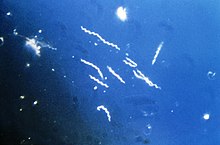
Back بوريليا برغدورفيرية Arabic بوريليا برغدورفيريه ARZ Borrelia burgdorferi Catalan Borrelien German Borrelia burgdorferi Spanish Borrelia burgdorferi Basque بورلیا بورگدورفری Persian Borrelia burgdorferi Finnish Borrelia burgdorferi French Borrelia burgdorferi Galician
| Borrelia burgdorferi | |
|---|---|

| |
| Borrelia burgdorferi | |
| Scientific classification | |
| Domain: | Bacteria |
| Phylum: | Spirochaetota |
| Class: | Spirochaetia |
| Order: | Spirochaetales |
| Family: | Borreliaceae |
| Genus: | Borrelia |
| Species: | B. burgdorferi
|
| Binomial name | |
| Borrelia burgdorferi Johnson et al. 1984 emend. Baranton et al. 1992
| |
Borrelia burgdorferi is a bacterial species of the spirochete class in the genus Borrelia, and is one of the causative agents of Lyme disease in humans.[1][2] Along with a few similar genospecies, some of which also cause Lyme disease, it makes up the species complex of Borrelia burgdorferi sensu lato. The complex currently comprises 20 accepted and 3 proposed genospecies.[2] B. burgdorferi sensu stricto exists in North America and Eurasia and until 2016 was the only known cause of Lyme disease in North America.[3][4][2] B. burgdorferi are often mistakenly described as Gram negative because of their two external membranes, but they lack lipopolysaccharide and possess many surface lipoproteins, unlike true Gram-negative bacteria.[5]
- ^ Radolf JD, Samuels DS, eds. (2021). Lyme Disease and Relapsing Fever Spirochetes: Genomics, Molecular Biology, Host Interactions, and Disease Pathogenesis. Caister Academic Press. ISBN 978-1-913652-61-6.
- ^ a b c Wolcott, Katherine A.; Margos, Gabriele; Fingerle, Volker; Becker, Noémie S. (September 2021). "Host association of Borrelia burgdorferi sensu lato: A review". Ticks and Tick-borne Diseases. 12 (5): 101766. doi:10.1016/j.ttbdis.2021.101766. PMID 34161868.
- ^ CDC (2016-02-08). "New Lyme-disease-causing bacteria species discovered". Centers for Disease Control and Prevention. Retrieved 2019-01-18.
- ^ Tilly, Kit; Rosa, Patricia A.; Stewart, Philip E. (2008). "Biology of Infection with Borrelia burgdorferi". Infectious Disease Clinics of North America. 22 (2): 217–234. doi:10.1016/j.idc.2007.12.013. PMC 2440571. PMID 18452798.
- ^ Samuels DS; Radolf, JD, eds. (2010). "Chapter 6, Structure, Function and Biogenesis of the Borrelia Cell Envelope". Borrelia: Molecular Biology, Host Interaction and Pathogenesis. Caister Academic Press. ISBN 978-1-904455-58-5.